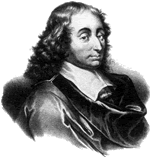Pascaline
 Blaise Pascal
hardware software keywords |
General
Description
The machine is called the 'Pascaline'. While several models were completed, Pascal's machine was more likely to be found in the living rooms of their owners as a conversation piece rather than in the office.23 Pascal according to his memoirs develops the machine because he had to help his father with his work as tax receiver. The calculations are done with a kind of Abax, using little stones to add and subtract. This is boredom Pascal said and started to make the a machine that later became known as the Pascaline. The genius of the machine is that Pascal realized how the tens and hundreds could be carried This had to be solved first if one could work with numbers larger than 10 with the help of a machine Pascal used the following principle: When a gear with ten teeth made one rotation (tens) a second gear shift one tooth until that gear rotated ten times (hundreds) that shifts another gear (thousands) etc. This principle is still used in odometers in cars, pumps of petrol stations, and your electricity meters at home. The numbers to be added are set up via some turning discs on the bottom. After crunching a handle the answer appeared in a window. In this way the machine only could add. Subtracting required some adaptations to it so it counted "backwards". Division and multiplication can be done by repeating the adding or subtractions. This is the way most mechanical calculators still work! The introduction of the Pascaline is no commercial success. Compared with the cost of labor the Pascaline is too expensive. Apart from that there is a pressure on the employers by the white collar workers to dump the machine afraid as they are to loose their jobs. There were build 50 Pascalines. And some are on display in the Conservatoir des arts et métiers, 292 Rue Saint Martin, at Paris, and the Science Museum at London. Blaise Pascal is in his time a wonder child on mathematics and implementations of it. His invention of the counting machine grew out of necessity but also opened the way for more complicated counting machines by later generations of inventors.
Chronology
|
![]()
| Last Updated on | For suggestions please mail the editors |
Footnotes & References
| 1 | Frank Hayes 1999 |
| 2 | main body of text based on: WHGB |